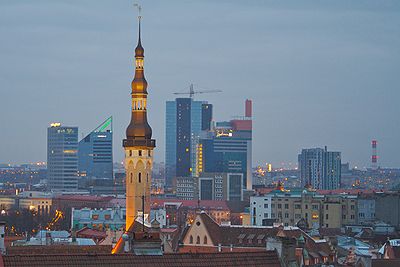Chris Miller concedes he doesn’t have an Estonian-sounding name. That’s probably because the president of Illuminomics, a Savannah, Ga.-based urban consulting firm, isn’t Estonian.
But he’d heard about “this far away, postage stamp place where they were doing crazy things like teaching first-graders to program computers.” Miller was speaking of the city of Tallin, Estonia, at the i-Canada Alliance‘s summit The Seven Habits of Highly Intelligent Communities in Toronto on Monday.
RELATED CONTENT
Tallin is one of several communities represented at the forum that are finalists for the title of Intelligent Community of the Year at the ICF’s Intelligent Community Summit in New York later this week. Of the seven finalists announced in January, two are from Ontario: Toronto and Stratford.
The Baltic state has had a history of almost continuous occupation by other countries, Poland, Denmark, Germany and Russia among them. “It’s a tough neighbourhood,” Miller said. The country is about the size of the Netherlands, but with a tenth of the population. At 1.3 million people, it’s among the smallest of of the Eurozone countries, but with the highest gross domestic product of an of the former Soviet republics.
In fact, on most quality of living metrics — education, press freedom, civil liberties and education — it consistently ranks among the highest in Europe. The Internet is a human right in Estonia, not a luxury. The country has a national network for recharging electric vehicles. Stron government partnerships, low taxes and low barriers to business all contribute. “It worked because they made generational jumps,” Miller said, acknowledging the influence of nearby Finland. Helsinki, Finland’s capital, is about a 45-minute ferry ride away, and Tallin, Estonia’s largest city, is “essentially a suburb of Helsinki,” Miller said.

Miller recounted how he’d forgotten to turn off his data roaming on his smart phone in Germany and ran up a $750 bill in 14 minutes. To those who have made the same mistake, he offers this consolation: In Estonia, you can walk from border to border without losing contact with a free Wi-Fi network.
Upon declaring independence in 1991, Estonia “nuked and paved” its Soviet era institutional infrastructure, Miller said, starting essentially from scratch with a young and bold government. The “Tiger’s Leap” program of the late 1990s poured government investment into technological infrastructure, particularly in schools. Estonian developers created Kazaa and Skype.
Such reinvention is a common theme among nominees. Stratford was North America’s largest rail centre at the turn of the century, and once manufactured 80 per cent of Canada’s furniture, said mayor Dan Mathieson. With those industries gone, the town was forced to reinvent itself, embracing post-secondary education, information and communications technology businesses, startups and accelerators.
Critically, when Ontario’s power grid was privatized, Stratford not only bought its own, but those of four neighbouring communities as well. That ensured a stable electrical supply and facilitated the creation of the town’s 70-kilometre fibre backbone and ubiquitous mesh Wi-Fi network, Mathieson said.
Creative response to challenges is another hallmark of nominee cities.
“You can build condos til the cows come home,” but that won’t bring jobs to the downtown, said John Campbell, president and CEO of Waterfront Toronto. With most of the waterfront up for development in government hands, Waterfront Toronto and a partner ISP were able to make high-speed Internet mandatory for condominium developments. Priced at a premium, that margin offsets the cost of providing high-speed for lower-income housing developments.
The $30-billion redevelopment of Toronto’s waterfront has also attracted high-tech, LEED-certified office space and a digitally sophisticated campus of George Brown College.
Suvi Linden, Finland’s former communications minister, spoke of the challenges and opportunities facing Oulu, often referred to as the capital of northern Scandinavia. Oulu was a finalist in 2012 as well as this year.
The decline of mobile phone maker Nokia hasn’t been kind to Oulu. The city of 230,000 has lost 2,000 jobs since 2010 due to Nokia layoffs.
However, she said, Oulu is well-placed to face the challenge. One-third of its residents have a university degree, there’s a student population of 40,000 and Nokia left behind a legacy of highly educated engineers now opening their own businesses.
“We still strongly believe we can go over these obstacles,” she said.